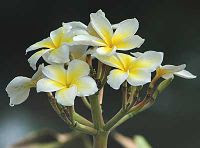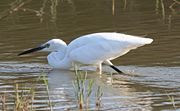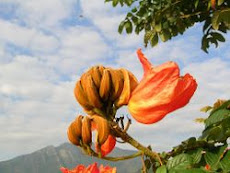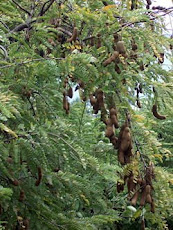
There are 97 kinds of birds at Fensang Reservoir.
Se puede encontrar 97 tipos de ave en el Deposito Fensang.
鳳山水庫為水源管制區,水庫內林相蒼鬱,自然生態資源豐富多元,也因環境清幽、人車干擾少,更成為野生鳥類最佳的良好棲所。 根據高雄市野鳥學會所進行的鳥類調查顯示,鳳山水庫出現的鳥類至少有29科97種鳥類;其中留鳥42種、冬候鳥25種、夏候鳥3種、過境鳥19種、外來種7種、迷鳥1種。而在這些鳥種中,尤以每年十月中旬來台渡冬的鸕鶿最引人注目,其在鳳山水庫渡冬的數量,正逐年增加,從86年的772隻到91年的2176隻,不僅已成為當地特殊的生態景觀,也使鳳山水庫成為台灣本島最大的鸕鶿夜棲地。 不但如此, 周圍林相完整, 春天可看到 赤腹鷹 和灰面鷲
北返的盛況喔 !!

鸕鶿是高屏溪口數量頗大的冬候鳥,每年十一月左右出現在高屏溪口,偶而會成群或少數出現在紅樹林生態區的河域中。鸕鶿生性機警,由於高屏溪口干擾太大,鸕鶿都以鳳山水庫為大本營,清晨結隊從鳳山水庫出發,飛到高屏溪口享用鮮魚早餐,等到飽餐天亮後,溪口人類活動漸多,干擾漸大,再成群齊飛,上空盤旋,如烏雲蔽空,然後以「人」字形回鳳山水庫休息。 鸕鶿,長約78-86公分,為普遍的冬候鳥,全身大致黑色,嘴長有細牙如鋸,尖端倒鉤如鷹嘴,眼翠綠色;亞成鳥腹部有明顯白狀或不規則褐色狀;夏天成鳥頭部白色,上頭至後頭較長(龐克狀)為繁殖羽,肋部兩側有白斑塊。獵魚功夫一流,能潛入數十公尺水中追捕游魚,喜歡結群潛水圍捕魚類,因缺乏油腺,故上岸後常將兩翅展開晾曬,經常張口散熱並鼓動喉部;停在水面上時,頭會呈15度仰角。飛行大抵成縱列群飛,在水面上多貼近水面飛行。每年約十月來台渡冬棲息,隔年四月北返。又稱烏鬼,過去大陸漁民綁在船上用來捕魚的工具,有集體合作捕食的行為,目前在鳳山水庫的數量台灣第一;每天清晨牠們會出外覓食,在柴山、蓮池潭偶而可以見到牠們的身影。
The bird family Phalacrocoracidae is represented by some 40 species of cormorants and shags. Several different classifications of the family have been proposed recently, and the number of genera is disputed.
Cormorants and shags are medium-to-large seabirds. They range in size from the Pygmy Cormorant (Phalacrocorax pygmaeus), at as little as 45 cm (18 in) and 340 g (12 oz), to the Flightless Cormorant (Phalacrocorax harrisi), at a maximum size 100 cm (40 in) and 5 kg (11 lb). The recently-extinct Spectacled Cormorant (Phalacrocorax perspicillatus) was rather larger, at an average size of 6.3 kg (14 lb). The majority, including nearly all Northern Hemisphere species, have mainly dark plumage, but some Southern Hemisphere species are black and white, and a few (e.g. the Spotted Shag of New Zealand) are quite colourful. Many species have areas of coloured skin on the face (the lores and the gular skin) which can be bright blue, orange, red or yellow, typically becoming more brightly coloured in the breeding season. The bill is long, thin, and sharply hooked. Their feet have webbing between all four toes, as in their relatives. This species is a cold blooded bird. it's temperature is known to be reported at 23 Celsius norm and 34 after 2 hours of sunbathing.
Cormorants resting on a skerry i a storm near Hustadvika, Møre og Romsdal county, Norway
Imperial Shags in Beagle Channel
Cormorants nesting on an island at Walthamstow Reservoirs
They are coastal rather than oceanic birds, and some have colonised inland waters - indeed, the original ancestor of cormorants seems to have been a fresh-water bird, judging from the habitat of the most ancient lineage. They range around the world, except for the central Pacific islands.
All are fish-eaters, dining on small eels, fish, and even water snakes. They dive from the surface, though many species make a characteristic half-jump as they dive, presumably to give themselves a more streamlined entry into the water. Under water they propel themselves with their feet. Some cormorant species have been found, using depth gauges, to dive to depths of as much as 45 metres.
After fishing, cormorants go ashore, and are frequently seen holding their wings out in the sun; it is assumed that this is to dry them, It is in fact now known that they are heating their cold prey before entering the stomach to prevent vomiting. Unusually for a water bird, their feathers are not waterproofed. This may help them dive quickly, since their feathers do not retain air bubbles.
Cormorants are colonial nesters, using trees, rocky islets, or cliffs. The eggs are a chalky-blue colour. There is usually one brood a year. The young are fed through regurgitation. They typically have deep, ungainly bills, showing a greater resemblance to those of the pelicans', to which they are related, than is obvious in the adults.
[edit] Systematics
The cormorants are a group traditionally placed within the Pelecaniformes or, in the Sibley-Ahlquist taxonomy, the expanded Ciconiiformes. This latter group is certainly not a natural one, and even after the tropicbirds have been recognized as quite distinct, the remaining Pelecaniformes seem not to be entirely monophyletic. Their relationships and delimitation - apart from being part of a "higher waterfowl" clade which is similar but not identical to Sibley and Ahlquist's "pan-Ciconiiformes" - remain mostly unresolved.
Notwithstanding, all evidence agrees that the cormorants and shags are closer to the darters and Sulidae (gannets and boobies), and perhaps the pelicans and/or even penguins, than to all other living birds[2]. In recent years, three preferred treatments have emerged: either to leave all living cormorants in a single genus, Phalacrocorax, or to split off a few species like the Imperial Shag complex (in Leucocarbo) and perhaps the Flightless Cormorant. Alternatively, the genus may be disassembled altogether and in the most extreme case be reduced to the Great, White-breasted and Temminck's Cormorants.[3]
Pending a thorough review of the Recent and prehistoric cormorants, the single-genus approach[4] is followed here for three reasons: First, it is preferable to tentatively assigning genera without a robust hypothesis. Second, it makes it easier to deal with the fossil forms, the systematic treatment of which has been no less controversial than that of living cormorants and shags. Third, this scheme is also used by the IUCN[5], making it easier to incorporate data on status and conservation. In accordance with the treatment there, the Imperial Shag complex is here left unsplit too, but the King Shag complex is split up.
Several evolutionary groups are still recognizable. However, combining the available evidence suggests that there has also been a great deal of convergent evolution; for example the "cliff shags" are a convergent paraphyletic group. The proposed division into Phalacrocorax sensu stricto (or subfamily Phalacrocoracinae) "cormorants" and Leucocarbo sensu lato (or Leucocarboninae) "shags"[6] does indeed have some degree of merit - though not as originally intended - but fails to account for basal lineages and the fact that the entire family cannot be clearly divided at present beyond the superspecies or species-complex level[7]. The resolution provided by the mtDNA 12S rRNA and ATPase subunits 6 and 8 sequence data[7] is not sufficient to properly resolve several groups to satisfaction; in addition, many species remain unsampled, the fossil record has not been integrated in the data, and the effects of hybridization - known in some Pacific species especially - on the DNA sequence data are unstudied.
.jpg)
大捲尾生性好鬥,攻擊力強,加上牠們的飛行技術高超,飛行中急速轉換方向對牠們來說輕而易舉,只要有其他鳥類侵入其領域範圍,都不免被牠修理一頓。即使是大冠鷲、老鷹等猛禽,遇到牠也得落荒而逃。有一首童謠 : 「烏秋烏秋嘎嘎啾,刺瓜仔肉溫豆油,豆油捧咧走,烏秋烏秋罵罵嘎」。在大捲尾的繁殖期,若經過牠的巢窩附近,就連人類也難逃被牠攻擊的命運,電視新聞就常看到大捲尾追著人跑的有趣畫面。
The Black Drongo, Dicrurus macrocercus, is a small Asian bird. The drongos are passerines restricted to the Old World tropics. They were previously classed as the family Dicruridae, but that has been much enlarged to include a number of largely Australasian groups, such as the Australasian fantails and the monarchs and paradise flycatchers.
The Black Drongo is a common resident breeder in much of tropical southern Asia from southwest Iran through India and Sri Lanka east to southern China and Indonesia.
This species is usually found in open forests and similar lightly wooded habitats, including farmland and habitation. Three or four eggs are laid in a light cup nest placed in a fork often on the bare outer branches of trees.
These are aggressive and fearless birds, 28 cm in length, and will attack much larger species if their nest or young are threatened. There are also some cases of Drongos preying on small birds. They have also been on occasion seen feeding on dead fish.
The adult Black Drongo is mainly glossy blue-black, although the wings are duller. The tail is long and deeply forked, and there is a white spot in front of the eye. Young birds are dull dark brown.
The Black Drongo has short legs and sits very upright whilst perched prominently, like a shrike. It eats insects and other small animals.
El drongo real es una especie de drongo ampliamente distribuido por Asia: se le encuentra desde Sri Lanka al sur de China y de Irán hasta Indonesia.

The river kingfishers or Alcedinidae, are one of the three families of bird in the kingfisher group.
The family is widespread through Africa, through east and south Asia as far as Australia, with one species, the River Kingfisher or European Kingfisher (Alcedo atthis) also appearing in Europe and northern Asia. The origin of the family is thought to have been in Asia
La familia Alcedinidae es una de las tres familias de martines pescadores del suborden Alcedines en el orden Coraciiformes. Se distribuye por África, por el este y sur de Asia, hasta Australia y en Europa con una sola especie (Alcedo atthis). Se piensa que la familia tiene su origen en Asia.

黑冠麻鷺,學名Gorsachius melanolophus 中等大小。分佈在亞洲南部、東部和東南亞,繁殖在印度、中國和菲律賓。
黑冠麻鷺站立時大約47公分高。棲習於森林裏並常夜間活動,遇警時會伸長脖子擬態,在繁殖期入夜後會站在樹枝上向四方大聲鳴叫。成鳥有黑冠、面孔和脖子為紅棕色,背部為黑暗的紅棕色,腹部有細條紋,翼黑。亞成鳥是灰棕色有黑和白色斑點,並且下部有斑紋。
因普遍出現在廣闊的地區,黑冠麻鷺在IUCN紅色名錄中被評估為可最低關注的物種。
The Malayan Night Heron, Gorsachius melanolophus, also known as Malaysian Night Heron, is a medium-sized heron. It is distributed in south, east and southeast Asia, breeding in India, China and the Philippines. The Malayan Night Heron stands about 47cm tall. It is nocturnal and is found in forests. Adults have black crowns, reddish-brown faces and necks, dark reddish-brown underparts with fine streaks, and black wings. The juvenile is greyish-brown with black and white spots, and its underparts are streaked. Widespread throughout its large range, the Malayan Night Heron is evaluated as Least Concern on the IUCN Red List of Threatened Species.
La garza nocturna caledónica, garza nocturna tigresa o martinete malayo es una especie de ave de la familia Ardeidae presente en buena parte de Asia. Existen importantes poblaciones nidificantes en China, India y Filipinas.

白鷺體長61cm,白色,繁殖期間頭上有兩條細長的冠羽作為飾羽;細長黑喙;黑腿,黃腳掌;叫聲:于繁殖巢群中發出呱呱叫聲。 魚、甲殼動物和昆蟲。以各式魚蝦為主食,覓食時會有用一隻腳在水中踩踏。 繁殖期和黃頭鷺、夜鷺集體築巢於竹林、相思樹林、木麻黃林中,繁殖期為3-9月。繁殖期眼先變成紅色;頭後有二根飾羽,長度可達21.5公分;背部有上捲的蓑羽13-49根不等(周鎮1995)。通常雌雄共同以約手指頭粗的樹枝築成盤形巢,鳥巢簡單的有如一堆枯枝。雌雄共同孵卵、育雛。小白鷺每窩產蛋4-5枚,蛋為淺藍色
The adult Little Egret is 55–65 cm long with an 88–106 cm wingspan. It weighs 350–550 grams. Its plumage is all white. It has long black legs with yellow feet and a slim black bill. There is . In the breeding season, the adult has two long nape plumes and gauzy plumes on the back and breast. The bare skin between the bill and eyes becomes red or blue. Juveniles are similar to non-breeding adults but have duller legs and feet. The subspecies garzetta has yellow feet and a bare patch of grey-green skin between the bill and eyes, whereas nigripes has yellow skin between the bill and eye and blackish feet.
Little Egrets are mostly silent but make various croaking and bubbling calls at their breeding colonies and produce a harsh alarm call when disturbed.
Its original breeding distribution was large inland wetlands and coastal wetlands in warm temperate parts of Europe, Asia, Africa and Australia.
In warmer locations, most birds are permanent residents; northern populations, including many European birds, migrate to Africa and southern Asia. They may also wander north after the breeding season, which presumably has led to this egret's range expansion.
The Little Egret nests in colonies, often with other wading birds, usually on platforms of sticks in trees or shrubs or in a reedbed or bamboo grove. In some locations such as the Cape Verde Islands, the species nests on cliffs. Pairs defend a small breeding territory, usually extending around 3–4 m from the nest. The three to five eggs are incubated by both adults for 21–25 days to hatching. They are oval in shape and have a pale, non-glossy, blue-green colour. The young birds are covered in white down feathers, are cared for by both parents and fledge after 40 to 45 days.
This egret stalks its prey in shallow water, often running with raised wings or shuffling its feet. It may also stand still and wait to ambush prey. It eats a variety of small animals including fish, amphibians, crustaceans, and insects.
Adulto: Plumaje enteramente blanco; durante el verano, tiene en la coronilla 2 plumas muy largas, estrechas y puntiagudas que sobresalen por detrás; las escapulares también sobresalen por encima de la cola; pico negro con la base de la mandíbula inferior gris verdoso; patas negras con los dedos amarillos. Joven: Como el adulto.
Árboles y arbustos situados en las inmediaciones del agua. En ocasiones, también entre la vegetación palustre. 1 puesta (3-5 huevos) entre Abril y Agosto. Nidifica en colonias laxas.











